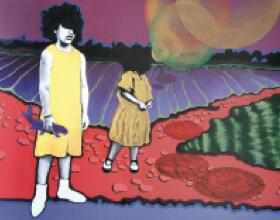Héctor Maldonado
The Moore Building, Miami
If there is something conclusive in the work of Héctor Maldonado (Puerto Rico, 1972) it is his versatility. The plurality of concepts and resources in present day aesthetic practices is linked to the hybridization of the supports for visual expression, and Blood and Toys II, the project The Moore Building is exhibit- ing, proves to be a solid compendium of the simultaneity of mediums with which numerous emerging talents usually work. The artist’s thorough academic training is a determining factor for the apprehension and ductility of the fragments necessary to build a discourse with a deep introspective repercussion. Maldonado holds a Master of Fine Arts degree from the University of Puerto Rico and also an MFA from the National Autonomous University of Mexico. Although his first exhibition dates back to 1997, it was only a decade later that his work gradually matured towards the polysemy through which he currently induces us to readings of gradual submersion.

In Blood and Toys II, the artist has diversified a first version shown months earlier at Borinquen Gallery, although the presentation structure continues to revolve around the three original nuclei. One of them is the series My Family, composed of renderings midway between narrative figuration and pop portrait painting, in which the author proposes a sociological exploration of the family environment resorting to evocations of the graphic memorabilia related to his personal experiences. The compiled images are recreated and distributed on the two-dimensionality of the canvas through a metaphorical rearrangement and a brush that disguises or highlights the figure, incorporating symbols, or sophisticating the chromatic sat- urations to recontextualize the signification of a visual record which had been, until that moment, a simple recollection and now submits to intellectual revisitation.
Identical treatment is applied to the series “Listen”, in which the theme of childhood is emphasized through inspired returns to child- hood photographs of relatives and friends through which the author continues with the revival of life experiences he has embarked on, completing it with the sculptural constructions of Void Toys, third series of pieces that the artist himself qualifies as “mutant objects”, and whose assemblage is derived from the Duchampian tradition of the objettrouvé. These small structures made of found objects and zealously kept for years with a playful feeling rather than with an intention to exhibit them complete Maldonado’s aesthetic recycling. The timeless freshness of these mini altar pieces, whose elaborate naivety insinuates certain critical commentary on consumption, closes with the spontaneous charm of its origins the epic of the retrospective journey. A singular way to plunge into himself, which from a reconsideration pending of identity of the individual environment relationship, guides us towards a nostalgia far detached from tourism. Jesús Rosado West





